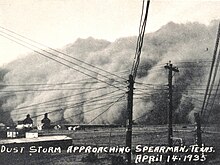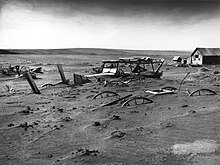Dust Bowl

The Dust Bowl was a series of dust storms causing major ecological and agricultural damage to American and Canadian prairie lands from 1930 to 1936 (in some areas until 1940), caused by severe drought conditions coupled with decades of extensive farming without crop rotation or other techniques that prevented erosion. The fertile soil of the Great Plains was exposed through removal of grass during plowing. During the drought, soil dried out, became dust, and blew away eastwards and southwards, mostly in large black clouds. At times, the clouds blackened the sky all the way to California, and much of the soil was completely deposited into the Atlantic Ocean. During the 1930's, large dust storms ravaged the Great Plains. This area was labled the "Dust Bowl" and the time period was called the "dirtythirties". The region of the Dust Bowl consisted of 100 million acres in the panhandles of Texas , Oklahoma, New Mexico, Colorado, and Kansas.
The storms of the Dust Bowl were given nicknames such as "Black Blizzard" and "Black Roller" because visibility was reduced to a few feet. The Dust Bowl was an ecological and human disaster. It was caused by misuse of land and years of sustained drought. Millions of acres of farmland became useless, and hundreds of thousands of people were forced to leave their homes. Degradation of dry lands claimed peoples' cultural heritage and livelihoods. Hundreds of thousands of families from the Dust Bowl (often known as the "Okies," since so many came from Oklahoma) traveled to California and other states, where they found conditions a little better than those they had left. Owning no land of their own, many workers as agricultural migrants, traveled from farm to farm picking fruit and other crops at starvation wages. There was more than one cause of the Dust Bowl. The major participant was the expansion of agriculture that set the stage for this disastrous period of soil erosion.
This ecological catastrophe, which began as the economic effects of the Great Depression were intensifying, caused an exodus from Texas, Oklahoma, Kansas, and the surrounding Great Plains, with over 500,000 Americans left homeless.[1] Many Americans migrated west looking for work while many Canadians fled to urban areas like Toronto. Some two-thirds of farmers in "Palliser's Triangle", in the Canadian province of Saskatchewan, had to rely on government aid to survive. This was due mainly to drought, hailstorms, and erratic weather rather than to dust storms such as those which were occurring on the U.S. Great Plains farther south.[2] Some residents of the Plains, in especially Kansas and Oklahoma, fell prey to illnesses and death from dust pneumonia and the effects of malnutrition.
Geographic Characteristics
The Dust Bowl area principally lies west of the 100th meridian on the High Plains, which are characterized by plains which vary from rolling in the north, to dead flat in the Llano Estacado. Elevation in the area ranges from 2500 feet in the east to 6000 feet above sea level at the base of the Rocky Mountains. The area is semi-arid, receiving less than 20 inches of rain annually; this rainfall supports the Shortgrass prairie biome originally present in the area. The region is also prone to extended periods of drought, alternating with periods of unusual wetness of equivalent duration. This does not help with the corn and goods that are grown[3] During wet years, the rich soil provides bountiful agricultural output, but crops fail during dry years. Furthermore, the region is subject to high winds, which are higher than any region in the area with the exception of coastal regions.[4]
Agricultural and settlement history
During the early exploration of the Great Plains, the region in which the Dust Bowl occurred was thought to be unsuitable for agriculture; indeed, the region was known as the Great American Desert. The lack of surface water and timber made the region less attractive for settlement and agriculture. However, following the Civil War, settlement in the area increased, encouraged by the Homestead Act and westward [5][6] A unusually wet period in the Great Plains led settlers to believe that "rain follows the plow" and the climate of the region had changed permanently.[7] The initial agricultural endeavors were primarily cattle ranching with some cultivation; however, a series of harsh winters beginning in 1886 coupled with overgrazing followed by a short drought in 1890 led to an expansion of land under cultivation. Immigration began again at the beginning of the 20th century, with a return of unusually wet weather which confirmed the previously held attitude that the "formerly" semi-arid area could support large-scale agriculture. Technological improvements led to increased automation, which allowed for cultivation on an ever greater scale. World War I increased agricultural prices, which encouraged farmers to drastically increase cultivation. In the Llano Estacado, farmland area doubled between 1900 and 1920, and land under cultivation more than tripled between 1925 and 1930.[8] Finally, farmers used agricultural practices which encouraged erosion; for example, cotton farmers left fields bare over winter months, when winds in the High Plains are highest, and burned their wheat stubble, which deprived the soil of organic matter and increased exposure to erosion.
Drought and Dust Storms

The unusually wet period which encouraged increased settlement and cultivation in the Great Plains ended in 1930 with the beginning of an extended and severe drought. The drought caused crops to fail, leaving the plowed fields exposed to wind erosion. The fine soil of the Great Plains was easily eroded and carried east by the strong winds of the region.
On November 11 1933, a very strong dust storm stripped topsoil from desiccated South Dakota farmlands in just one of a series of bad dust storms that year. Then on May 11 1934, a strong two-day dust storm removed massive amounts of Great Plains topsoil in one of the worst such storms of the Dust Bowl. The dust clouds blew all the way to Chicago where filth fell like snow. Several days later, the same storm reached cities in the east, such as Buffalo, Boston, New York City, and Washington, D.C. That winter, red snow fell on New England.
On April 14 1935, known as "Black Sunday", twenty of the worst "Black Blizzards" occurred throughout the Dust Bowl, causing extensive damage, turning the day to night. Witnesses reported that they could not see five feet in front of them at certain points.
Migrations

The Dust Bowl exodus was the largest migration in American history. By 1940, 2.5 million people had moved out of the Plains states; of those, 200,000 moved to California.[9] With their land barren and homes seized in foreclosure, many farm families were forced to leave. Migrants left farms in Kansas, Texas, and New Mexico, but all were generally referred to as "Okies". The plight of Dust Bowl migrants became widely known from the novel The Grapes of Wrath by John Steinbeck.
Government response
During President Franklin D. Roosevelt's first 100 days in 1933, governmental programs designed to restore the ecologic balance of the nation were implemented. The U.S. Government formed the Soil Conservation Service, which is now the Natural Resources Conservation Service (NRCS).
Influence on the arts
The human crisis was documented by photographers, musicians and authors of the time. Photographer Dorothea Lange made a name for herself while working as a photographer with the Farm Security Administration, capturing the impact of the storms on film. Independent artists like folk singer Woody Guthrie and novelist John Steinbeck both became famous for their depictions of life during the Dust Bowl of the 1930s.
Footnotes
- ^ "First Missed Century:Interview:James Gregory". PBS. Retrieved 2007-03-11.
- ^ ""The Dust Bowl"". CBC. Retrieved 2007-03-11.
- ^ "A History of Drought in Colorado: lessons learned and what lies ahead" (PDF). Colorado Water Resources Research Institute. February 2000.
{{cite web}}: Check date values in:|year=(help); Unknown parameter|accessmonthday=ignored (help); Unknown parameter|accessyear=ignored (|access-date=suggested) (help) - ^ "A Report of the Great Plains Area Drought Committee" (HTML). Hopkins Papers, Franklin D. Roosevelt Library. August 27 1936.
{{cite web}}: Check date values in:|year=(help); Unknown parameter|accessmonthday=ignored (help); Unknown parameter|accessyear=ignored (|access-date=suggested) (help) - ^ "The Great Plains: from dust to dust" (HTML). Planning Magazine. December 1987.
{{cite web}}: Unknown parameter|accessmonthday=ignored (help); Unknown parameter|accessyear=ignored (|access-date=suggested) (help) - ^ Regions at Risk: a comparison of threatened environments (HTML). United Nations University Press. 1995.
{{cite book}}: Unknown parameter|accessmonthday=ignored (help); Unknown parameter|accessyear=ignored (|access-date=suggested) (help) - ^ Drought in the Dust Bowl Years (HTML). National Drought Mitigation Center. 2006.
{{cite book}}: Unknown parameter|accessmonthday=ignored (help); Unknown parameter|accessyear=ignored (|access-date=suggested) (help) - ^ Regions at Risk: a comparison of threatened environments (HTML). United Nations University Press. 1995.
{{cite book}}: Unknown parameter|accessmonthday=ignored (help); Unknown parameter|accessyear=ignored (|access-date=suggested) (help) - ^ Worster, Donald (1979). Dust Bowl: The Southern Plains in the 1930's. Oxford University Press.
{{cite book}}: Cite has empty unknown parameters:|coauthors=and|author link=(help)
Further reading
- The Worst Hard Time: The Untold Story of Those Who Survived The Great American Dust Bowl, Timothy Egan, Houghton Mifflin Company, New York, 2006, hardcover, ISBN 0-618-34697-X.
- The Dust Bowl: Men, Dirt, and Depression, Paul Bonnifield, University of New Mexico Press, Albuquerque, New Mexico, 1978, hardcover. ISBN 0-8263-0485-0
- Survival in the Storm: The Dust Bowl Diary of Grace Edwards, Dalhart, Texas, 1935, Katelan Janke, Scholastic (September 2002), ISBN 0-439-21599-4
- Out of the Dust, Karen Hesse, Scholastic Signature. New York First Edition, 1997, hardcover (paperback January 1999). ISBN 0-590-37125-8
Bibliography
- Woody Guthrie, The (Nearly) Complete Collection of Woody Guthrie Folk Songs, Ludlow Music,New York (1963).
- Alan Lomax, Woody Guthrie, Pete Seeger, Hard-Hitting Songs for Hard-Hit People, Oak Publications, New York (1967).
- C.Vann Woodward, The Origins of the New South, Louisiana State University Press (1967).
See also
- 1936 North American heat wave
- Woody Guthrie
- Rain follows the plow
- The Plow That Broke the Plains
- Timeline of environmental events
- Natural disaster
- Desertification
- Ogallala Aquifer
- ''Letters from the Dust Bowl'' by Caroline Henderson. A first hand account
External links
- NASA Explains "Dust Bowl" Drought
- The Dust Bowl photo collection
- The Dust Bowl (EH.Net Encyclopedia)
- Black Sunday, April 14, 1935, Dodge City, KS
- The Bibliography of Aeolian Research
- Surviving the Dust Bowl, Black Sunday (April 14, 1935)
- The Plow That Broke The Plains
- Youtube Video: "The Great Depression, Displaced Mountaineers in Shenandoah National Park, and the Civilian Conservation Corps (C.C.C.)"
- Farming in the 1930s (Wessels Living History Farm)
- The Dust Bowl (University of South Dakota)
This article needs additional citations for verification. (June 2007) |
- Great Depression in the United States
- Agriculture in the United States
- Human migrations
- History of the American West
- Environmental disasters in the United States
- History of the United States (1918–1945)
- Natural disasters in Kansas
- Natural disasters in Oklahoma
- Natural disasters in Texas
- Droughts
- Environment of Kansas
- Environment of Oklahoma
- Environment of Texas
